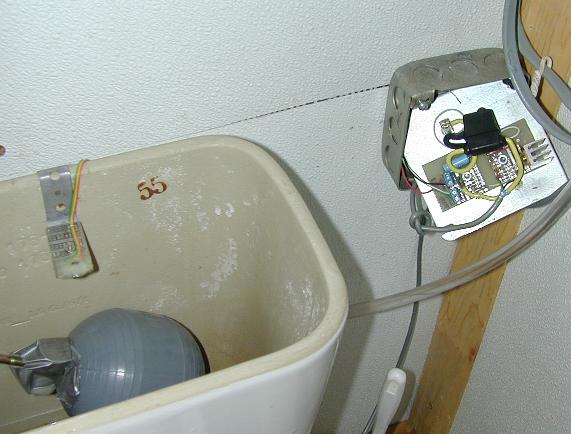
The 12V pump on the side of the cistern

The rev 1 circuit in action

The rev 2 circuit board

The schematic'
Introduction
A flushing toilet is something that most city dwellers take for granted, but it can be a luxury for those who live away from utility water and electricity. This circuit provides on-off pump switching for a small 12 Volt pump that is used to fill a toilet tank from an external rain water collection cistern. The 12 Volt power comes from a small solar power system. The cistern is located at ground level, so the pump is required to move the water up to the toilet tank.
Specifications
- Nominal operating voltage: 12V
- Idle current: < 1 ma
- Pump Current: < 5A
Theory
The Panasonic hall effect sensor is the heart of the system. The hall effect sensor’s output pulls to ground when in the presence of a relatively strong magnetic field. When the magnet is pulled away from the hall effect sensor, the output goes high via the 10K pull up resistor. This turns on the IRFZ34N MOSFET transistor, which pulls the negative lead of the 12V pump to ground, turning on the pump. The LED is also turned on. The 1N4004 diode snubs out potential spikes from the motor, and the 1000uF capacitor across the motor eliminates motor brush noise from the DC wiring. The 100uF capacitor filters noise from the 12V power source. As with all electrical circuitry, it is important to have a fuse and a switch in series with the power source, that is not shown in the schematic. The 10 amp silicon diode is used in a crowbar circuit. Its purpose is to protect the circuit from reverse DC polarity on the power terminals. Reverse polarity causes the fuse to blow. This circuit will work with most momentary action (non-latching) hall effect sensors, you may want to experiment with the sensor and magnet to find the most sensitive orientation for both parts.
Construction
The rev 1 version of this circuit had all of the parts inside of the toilet. This turned out to be a bad idea as water splashed onto the board and electrolysis corroded the electrical connections. Rev 2 involved splitting the circuit into two parts, the hall effect sensor assembly, and the rest of the electronics. The hall effect sensor was soldered to a small piece of circuit board, that was then screwed onto a piece of plumbing strap. The entire sensor assembly was then coated in epoxy glue to make it waterproof. A 100nF capacitor was connected from pins 1-3 on the hall effect sensor and also covered with epoxy, it reduces the chance of the sensor picking up stray radio signals. The rest of the circuit was built on another circuit board, that was mounted on the back side of a standard electrical box with wires running to the sensor, the pump motor, and the 12V supply. The magnet was connected to the toilet tank float with duct tape, a better magnet mount could certainly be fashioned. Sometimes it is necessary to cheat when working in the field. If the magnet has a gap around the side, fill it with silicone sealant to prevent rust. People in damp climates may want to seal the magnet in epoxy paint. The pump inlet is connected to a valve and reducer assembly at the bottom of the cistern tank. The pump outlet travels through a short section of conduit, into the building, and into the toilet tank via a piece of bent copper tubing. The copper tubing output should be above the highest water level to prevent back-siphoning. Another rev 2 modification was to put a water filter ahead of the pump, that prevents gunk from the tank from clogging the pump. The pump output tube and wiring were built with connectors so that the pump could be removed when we are away from the building. A more permanent version could be made by mounting the pump in a metal box on the side of the building.
Alignment
Bend the metal strap that holds the PC board, so that the hall effect sensor is directly above the magnet. Adjust the height of the PC board so that the circuit shuts off at the desired water level.
Use
Flush the toilet, the red LED will light up, and the pump will move water into the toilet tank. As soon as the water level reaches the top, the pump will shut off. Just like in the city. If you want to use this device in an area where the temperature gets below freezing, the water supply, pump, and water tubing will need to be mounted in an area that does not freeze, such as underground.
Sources
- Forrest Cook http://www.solorb.com/elect/